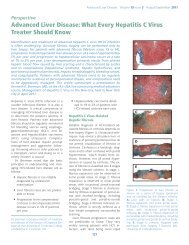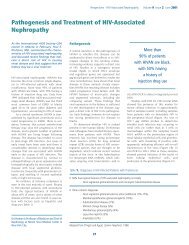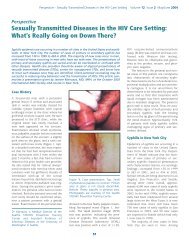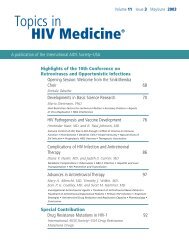Dermatologic Manifestations of HIV in Africa - International AIDS ...
Dermatologic Manifestations of HIV in Africa - International AIDS ...
Dermatologic Manifestations of HIV in Africa - International AIDS ...
Create successful ePaper yourself
Turn your PDF publications into a flip-book with our unique Google optimized e-Paper software.
<strong>International</strong> <strong>AIDS</strong> Society–USA<br />
Topics <strong>in</strong> <strong>HIV</strong> Medic<strong>in</strong>e<br />
Special Contribution<br />
<strong>Dermatologic</strong> <strong>Manifestations</strong> <strong>of</strong> <strong>HIV</strong> <strong>in</strong> <strong>Africa</strong><br />
Er<strong>in</strong> Huiras Amerson, MD, and Toby A. Maurer, MD<br />
<strong>Dermatologic</strong> disease is common <strong>in</strong> <strong>HIV</strong>-<strong>in</strong>fected <strong>in</strong>dividuals, and cl<strong>in</strong>icians<br />
car<strong>in</strong>g for patients with <strong>HIV</strong> <strong>in</strong>fection or <strong>AIDS</strong> <strong>in</strong> <strong>Africa</strong> are rout<strong>in</strong>ely confronted<br />
with sk<strong>in</strong> problems <strong>in</strong> their patients. Scarce access to dermatologic specialty<br />
care and limited educational resources describ<strong>in</strong>g the unique cl<strong>in</strong>ical<br />
characteristics <strong>of</strong> <strong>HIV</strong>-related sk<strong>in</strong> disease can make diagnos<strong>in</strong>g and treat<strong>in</strong>g<br />
sk<strong>in</strong> diseases a challenge <strong>in</strong> <strong>Africa</strong>. This article describes common <strong>HIV</strong>-related<br />
dermatologic conditions <strong>in</strong> <strong>Africa</strong> and their differential diagnoses and<br />
<strong>in</strong>cludes treatment strategies that are likely to be available locally. It is not<br />
meant to be comprehensive but rather to serve as a practical resource to<br />
aid practitioners by provid<strong>in</strong>g images <strong>of</strong> common conditions and describ<strong>in</strong>g<br />
dist<strong>in</strong>ctive cl<strong>in</strong>ical presentations <strong>of</strong> common conditions.<br />
The grow<strong>in</strong>g emphasis on global health<br />
and <strong>in</strong>ternational volunteerism is <strong>in</strong>creas<strong>in</strong>g<br />
the demand for cl<strong>in</strong>ical education<br />
applicable across cultures and<br />
borders. The majority <strong>of</strong> <strong>HIV</strong>-<strong>in</strong>fected<br />
<strong>in</strong>dividuals worldwide <strong>in</strong>habit develop<strong>in</strong>g<br />
countries, yet medical research<br />
and literature regard<strong>in</strong>g <strong>HIV</strong>- and <strong>AIDS</strong>associated<br />
dermatologic disease have<br />
focused overwhelm<strong>in</strong>gly on patterns <strong>of</strong><br />
sk<strong>in</strong> disease observed <strong>in</strong> white patients<br />
<strong>in</strong> resource-rich environments 1 . Differences<br />
<strong>in</strong> sk<strong>in</strong> pigmentation, climate,<br />
hygiene, and other genetic, environmental,<br />
demographic, and behavioral<br />
variables contribute to unique cl<strong>in</strong>ical<br />
presentations and epidemiologic patterns<br />
<strong>of</strong> <strong>HIV</strong>-associated sk<strong>in</strong> disease <strong>in</strong><br />
<strong>Africa</strong> compared with North America<br />
and Europe. Examples <strong>of</strong> <strong>HIV</strong>-related<br />
sk<strong>in</strong> diseases with divergent epidemiologic<br />
characteristics <strong>in</strong>clude the papular<br />
pruritic eruption (PPE) associated with<br />
<strong>HIV</strong>, Kaposi sarcoma (KS), cryptococcosis,<br />
and photodermatitis. Additionally,<br />
mutually common conditions such as<br />
seborrhea may have dist<strong>in</strong>ctive cl<strong>in</strong>ical<br />
presentations.<br />
This article may be used as a practical<br />
guide to dermatologic disease <strong>in</strong><br />
<strong>HIV</strong>-<strong>in</strong>fected <strong>in</strong>dividuals <strong>in</strong> <strong>Africa</strong>, focus<strong>in</strong>g<br />
on common diseases, as well as<br />
their differential diagnoses and treatments.<br />
It is not meant to be exhaustive,<br />
and given the dearth <strong>of</strong> medical literature<br />
regard<strong>in</strong>g <strong>HIV</strong> dermatology <strong>in</strong> <strong>Africa</strong>,<br />
the majority <strong>of</strong> the <strong>in</strong>formation is<br />
based on the experience and expertise<br />
<strong>of</strong> the authors. Readers are encouraged<br />
to consult the literature and experts <strong>in</strong><br />
the field for clarification or more <strong>in</strong>formation.<br />
In addition, local health regulations,<br />
drug approvals, and availabilities<br />
<strong>of</strong> specific treatments and procedures<br />
mentioned below vary considerably by<br />
region and are cont<strong>in</strong>uously evolv<strong>in</strong>g.<br />
Practitioners would benefit from consultation<br />
with others experienced with<br />
the local health care delivery system <strong>in</strong><br />
resource-limited sett<strong>in</strong>gs.<br />
Papular Pruritic Eruption<br />
PPE is a very common <strong>HIV</strong>-related sk<strong>in</strong><br />
disorder <strong>in</strong> tropical environments, <strong>in</strong>clud<strong>in</strong>g<br />
<strong>Africa</strong>. The underly<strong>in</strong>g etiology<br />
probably reflects a hypersensitivity to<br />
<strong>in</strong>sect bites, 2 hence the much higher<br />
<strong>in</strong>cidence <strong>in</strong> tropical than temperate<br />
climates. PPE presents as extremely<br />
pruritic 0.2- to 1-cm papules that are<br />
darker than the patient’s un<strong>in</strong>volved<br />
sk<strong>in</strong> (Figure 1). They may be excoriated<br />
from scratch<strong>in</strong>g and thickened or sh<strong>in</strong>y<br />
from rubb<strong>in</strong>g. The papules typically are<br />
numerous and predom<strong>in</strong>ate on the extremities,<br />
although the trunk may also<br />
be heavily <strong>in</strong>volved. The diagnosis is<br />
made cl<strong>in</strong>ically and can be confirmed<br />
by sk<strong>in</strong> biopsy when available. Immune<br />
reconstitution with antiretroviral<br />
therapy is the treatment <strong>of</strong> choice, but<br />
improvement typically takes at least 16<br />
weeks; pruritus sometimes improves<br />
with use <strong>of</strong> potent topical steroids or<br />
topical capsaic<strong>in</strong>.<br />
Figure 1. Papular pruritic eruption <strong>of</strong> <strong>HIV</strong>.<br />
Thickened, hyperpigmented papules <strong>of</strong> less<br />
than 1 cm favor<strong>in</strong>g the extremities.<br />
Differential Diagnoses to Consider<br />
Staphylococcal folliculitis. Bacterial<br />
folliculitis is a relatively common condition<br />
that may resemble PPE. Pruritus<br />
is variable, and lesions are typically<br />
fewer <strong>in</strong> number, are follicularly based,<br />
and may tend to be more concentrated<br />
on the upper trunk, upper arms, upper<br />
legs, and buttocks; pustules may<br />
be present. Treatment options <strong>in</strong>clude<br />
topical antiseptics (ie, chlorhexid<strong>in</strong>e)<br />
and topical or oral antistaphylococcal<br />
antibiotics.<br />
Eos<strong>in</strong>ophilic folliculitis. Less common<br />
<strong>in</strong> <strong>Africa</strong>, eos<strong>in</strong>ophilic folliculitis is a<br />
poorly understood <strong>HIV</strong>-related der-<br />
Dr Amerson is assistant pr<strong>of</strong>essor and Dr Maurer is associate pr<strong>of</strong>essor <strong>of</strong> dermatology at the University <strong>of</strong> California San Francisco.<br />
Send correspondence to Dr Maurer, San Francisco General Hospital, 1001 Potrero Ave, Ward 92, San Francisco, CA 94110. Received February<br />
22, 2010, accepted March 4, 2010.<br />
16
<strong>HIV</strong> Dermatology <strong>in</strong> <strong>Africa</strong> Volume 18 Issue 1 February/March 2010<br />
PPE. Patients present with an <strong>in</strong>tensely<br />
pruritic rash (Figure 3). The rash can<br />
appear papulonodular like PPE, pustular,<br />
eczematous, or even “crusted”<br />
<strong>in</strong> advanced <strong>HIV</strong> disease. Crusted, or<br />
“Norwegian,” scabies manifests with<br />
a thick, powdery, grayish scale that is<br />
teem<strong>in</strong>g with mites. Unlike PPE, scabies<br />
lesions tend to be clustered, sometimes<br />
with visible burrows, <strong>in</strong> the f<strong>in</strong>ger<br />
webs, around the waistl<strong>in</strong>e, and on<br />
the wrists and ankles. Cl<strong>in</strong>icians should<br />
always exam<strong>in</strong>e the axillae, breasts,<br />
umbilicus, and penis <strong>in</strong> men and boys;<br />
<strong>in</strong>volvement <strong>of</strong> these areas argues for<br />
a diagnosis <strong>of</strong> scabies over PPE or folliculitis.<br />
It is not unusual for the scratch<strong>in</strong>g<br />
to lead to bacterial super<strong>in</strong>fection.<br />
Commonly available treatment options<br />
<strong>in</strong>clude use <strong>of</strong> topical benzyl benzoate<br />
ester, 6% precipitated sulfur o<strong>in</strong>tment,<br />
or oral ivermect<strong>in</strong> where available.<br />
underly<strong>in</strong>g etiology but may be secondary<br />
to other <strong>HIV</strong>-related dermatoses<br />
(such as photodermatitis, eczema,<br />
or PPE), underly<strong>in</strong>g hepatitis C virus<br />
<strong>in</strong>fection, renal failure, or lymphoma.<br />
Treatment should be directed at the underly<strong>in</strong>g<br />
etiology, but symptoms can be<br />
treated with occlusion to provide physical<br />
protection from scratch<strong>in</strong>g, oral<br />
antihistam<strong>in</strong>es, potent topical steroids,<br />
and topical capsaic<strong>in</strong>.<br />
Figure 4. Prurigo nodularis. Large (> 1 cm),<br />
symmetric, hyperpigmented nodules.<br />
Seborrheic Dermatitis<br />
Figure 2. Two examples <strong>of</strong> eos<strong>in</strong>ophilic folliculitis.<br />
Itchy, follicularly based urticarial<br />
papules favor<strong>in</strong>g the head, neck, and upper<br />
trunk.<br />
matosis that, like PPE, is extremely<br />
pruritic. It may be differentiated from<br />
PPE based on its distribution, favor<strong>in</strong>g<br />
the face, neck, scalp, and upper trunk<br />
(and almost never occurr<strong>in</strong>g below the<br />
nipple l<strong>in</strong>e). The papules are typically<br />
more urticarial and less sh<strong>in</strong>y and hyperpigmented<br />
than <strong>in</strong> PPE (Figure 2).<br />
It <strong>of</strong>ten mimics acne cl<strong>in</strong>ically, but patients<br />
compla<strong>in</strong> <strong>of</strong> severe itch<strong>in</strong>g, which<br />
is not a feature <strong>of</strong> acne. It may appear<br />
or worsen temporarily dur<strong>in</strong>g immune<br />
reconstitution. Treatment <strong>of</strong> choice is<br />
antiretroviral therapy, but symptoms<br />
may be ameliorated with use <strong>of</strong> potent<br />
topical steroids or oral itraconazole<br />
200 mg to 400 mg daily.<br />
Scabies. Scabies <strong>in</strong>festation is very<br />
common and may be mistaken for<br />
Figure 3. Scabies. Extremely itchy papules<br />
clustered <strong>in</strong> the f<strong>in</strong>ger web spaces, with<br />
secondary staphylococcal super<strong>in</strong>fection.<br />
Prurigo nodularis. Relatively common,<br />
prurigo nodularis presents with<br />
<strong>in</strong>tensely pruritic, thickened, hyperpigmented,<br />
excoriated nodules (Figure 4).<br />
The nodules are larger (> 1 cm) and<br />
typically fewer <strong>in</strong> number (from 10-100<br />
lesions) than <strong>in</strong> PPE. Prurigo nodules<br />
<strong>of</strong>ten start on the extremities and are<br />
bilateral and symmetric. With cont<strong>in</strong>ued<br />
pruritus, they can become more<br />
widespread and appear on the trunk.<br />
Areas where patients cannot scratch,<br />
such as the midback, are spared. Prurigo<br />
nodularis results from <strong>in</strong>tense<br />
scratch<strong>in</strong>g and does not have a s<strong>in</strong>gle<br />
17<br />
As <strong>in</strong> the West, seborrhea is a very<br />
common sk<strong>in</strong> disorder associated with<br />
<strong>HIV</strong> <strong>in</strong>fection <strong>in</strong> <strong>Africa</strong>. Seborrheic dermatitis<br />
presents as a mildly itchy to nonitchy,<br />
scaly rash (Figure 5). Classically,<br />
the scalp, auditory canals, postauricular<br />
sk<strong>in</strong>, and hair-bear<strong>in</strong>g areas <strong>of</strong> the<br />
face and body (eyebrows, alar creases,<br />
beard, central chest, and axillae) are<br />
affected with erythema and “greasy”<br />
scale. However, <strong>in</strong> the authors’ experience,<br />
seborrhea has a much more<br />
varied cl<strong>in</strong>ical presentation <strong>in</strong> <strong>Africa</strong>. It<br />
may spare the face altogether, affect<strong>in</strong>g<br />
the scalp, ears, and sk<strong>in</strong> folds such as<br />
the axillae, antecubital fossae, and <strong>in</strong>ner<br />
thighs. It may also present as a rash<br />
with “powdery” scale and very little underly<strong>in</strong>g<br />
erythema, favor<strong>in</strong>g the scalp,<br />
ears, neck, shoulders, and back. It can<br />
occasionally present as erythroderma<br />
(full-body erythema and scale). There<br />
may be overlap with <strong>in</strong>verse psoriasis<br />
or eczema. Treatment depends on severity.<br />
Typically a comb<strong>in</strong>ation <strong>of</strong> topical<br />
antifungal drugs directed at Pityrosporum<br />
yeast and low- to midpotency<br />
topical steroids for <strong>in</strong>flammation will<br />
lead to improvement.
<strong>International</strong> <strong>AIDS</strong> Society–USA<br />
Topics <strong>in</strong> <strong>HIV</strong> Medic<strong>in</strong>e<br />
Figure 5. Seborrheic dermatitis. Papules<br />
with f<strong>in</strong>e, powdery scale distributed around<br />
the neck, shoulders, and axillae.<br />
Differential Diagnoses to Consider<br />
Photodermatitis. Counter<strong>in</strong>tuitively,<br />
dermatitis caused by sun exposure is<br />
more frequently observed <strong>in</strong> persons<br />
with darker sk<strong>in</strong> types and is very common<br />
<strong>in</strong> <strong>HIV</strong>-<strong>in</strong>fected persons <strong>in</strong> <strong>Africa</strong>.<br />
It can sometimes be quite difficult to<br />
differentiate from seborrhea. Photodermatitis<br />
presents as an itchy, scaly<br />
rash affect<strong>in</strong>g the sun-exposed regions<br />
<strong>of</strong> the sk<strong>in</strong> (the face, neck, “v” <strong>of</strong> the<br />
chest, dorsal arms, and sometimes<br />
lower legs and dorsal feet), spar<strong>in</strong>g sk<strong>in</strong><br />
that is protected from the sun anatomically<br />
(eg, under the ch<strong>in</strong>) or by cloth<strong>in</strong>g<br />
(Figure 6). This distribution is <strong>of</strong>ten<br />
cl<strong>in</strong>ically apparent when the patient’s<br />
shirt is removed. <strong>HIV</strong> <strong>in</strong>fection itself is<br />
photosensitiz<strong>in</strong>g, and many <strong>HIV</strong>-<strong>in</strong>fected<br />
patients are tak<strong>in</strong>g photosensitiz<strong>in</strong>g<br />
drugs such as sulfonamides. Treatment<br />
<strong>in</strong>cludes immune restoration, sunprotective<br />
cloth<strong>in</strong>g such as hats and<br />
long-sleeved shirts, and potent topical<br />
steroids. Many <strong>of</strong> these patients earn a<br />
liv<strong>in</strong>g work<strong>in</strong>g outside, and sunscreens<br />
are not widely available, mak<strong>in</strong>g avoidance<br />
<strong>of</strong> sun exposure especially difficult.<br />
The authors do not recommend<br />
stopp<strong>in</strong>g sulfonamide prophylaxis because<br />
<strong>of</strong> photodermatitis; rather, these<br />
patients should be immune reconstituted<br />
to a level at which prophylaxis is<br />
no longer <strong>in</strong>dicated.<br />
Figure 6. Photodermatitis. Itch<strong>in</strong>g, scal<strong>in</strong>g,<br />
and hyperpigmentation <strong>in</strong>volv<strong>in</strong>g sun-exposed<br />
sk<strong>in</strong>.<br />
acute and weep<strong>in</strong>g, or chronically dry<br />
and scaly (Figure 7). A background <strong>of</strong><br />
xerosis (dry sk<strong>in</strong>) is <strong>of</strong>ten present. Typically<br />
affected areas <strong>in</strong> adults <strong>in</strong>clude<br />
the eyelids, neck, flanks, hands, antecubital<br />
and popliteal fossae, and lower<br />
legs. Moister areas, such as the axillary<br />
sk<strong>in</strong>, are typically spared. Treatment<br />
focuses on use <strong>of</strong> topical steroids and<br />
emollients and on avoidance <strong>of</strong> dessicat<strong>in</strong>g<br />
agents such as soaps. Emollients<br />
(such as petrolatum) should be applied<br />
immediately after bath<strong>in</strong>g, while the<br />
sk<strong>in</strong> is still moist.<br />
Figure 7. Eczema. Chronic dry, scaly pruitic<br />
sk<strong>in</strong> affect<strong>in</strong>g the popliteal fossae.<br />
Psoriasis. Psoriasis is relatively common<br />
<strong>in</strong> the <strong>HIV</strong>-<strong>in</strong>fected population<br />
<strong>in</strong> <strong>Africa</strong> and may present with typical<br />
sharply demarcated, round, thick,<br />
scaly papules and plaques favor<strong>in</strong>g the<br />
extensor extremities (Figure 8A). Atypical<br />
presentations, such as <strong>in</strong>verse psoriasis<br />
affect<strong>in</strong>g the <strong>in</strong>tertrig<strong>in</strong>ous areas<br />
and erythroderma, are common. There<br />
may be substantial overlap with seborrhea,<br />
with disease affect<strong>in</strong>g the scalp,<br />
axillae, and <strong>in</strong>ner thighs (Figure 8B).<br />
Destructive arthritis may be a feature.<br />
Most psoriasis will improve with antiretroviral<br />
therapy. Additional treatment<br />
is usually limited to use <strong>of</strong> topical steroids<br />
and short-contact anthral<strong>in</strong> therapy.<br />
Systemic agents are not rout<strong>in</strong>ely<br />
available or affordable, though this<br />
may vary by region. Psoriasis that has<br />
stabilized with antiretroviral therapy<br />
but suddenly flares may <strong>in</strong>dicate a concomitant<br />
dermatologic condition such<br />
as scabies or staphylococcal <strong>in</strong>fection,<br />
or it may be a marker <strong>of</strong> failure <strong>of</strong> current<br />
antiretroviral therapy. When pso-<br />
Eczema. Advanced <strong>HIV</strong> disease causes<br />
dry sk<strong>in</strong>, which can lead to eczema.<br />
Eczema is always pruritic and may be<br />
Figure 8. Psoriasis (A). Typical sharply demarcated erythematous plaques with "silvery" scale.<br />
Inverse psoriasis (B). Erythema and scale <strong>of</strong> the sk<strong>in</strong> folds. There is overlap with seborrheic<br />
dermatitis.<br />
18
<strong>HIV</strong> Dermatology <strong>in</strong> <strong>Africa</strong> Volume 18 Issue 1 February/March 2010<br />
riasis is suspected, other differential<br />
diagnoses to consider <strong>in</strong>clude reactive<br />
arthritis (Reiter syndrome) and secondary<br />
syphilis.<br />
Drug Eruptions<br />
With the roll-out <strong>of</strong> antiretroviral therapy<br />
<strong>in</strong> <strong>Africa</strong>, associated drug eruptions<br />
occur commonly. Two types <strong>of</strong> drug<br />
eruptions that deserve special mention<br />
are Stevens-Johnson syndrome/toxic<br />
epidermal necrolysis (SJS/TEN) and<br />
s<strong>in</strong>gle or multiple fixed-drug eruptions<br />
(Figure 9).<br />
Figure 9. Toxic epidermal necrolysis. Note<br />
<strong>in</strong>volvement <strong>of</strong> the lips and eyes and sk<strong>in</strong><br />
erosions with typical angular borders.<br />
In the case <strong>of</strong> simple drug eruptions<br />
that are not life-threaten<strong>in</strong>g or <strong>in</strong>capacitat<strong>in</strong>g<br />
to the patient, cl<strong>in</strong>icians may<br />
elect to “treat through” the symptoms<br />
with topical steroids and antihistam<strong>in</strong>es.<br />
In this situation, patients should<br />
be monitored closely for the development<br />
<strong>of</strong> blisters, mucous membrane<br />
<strong>in</strong>volvement, or systemic symptoms.<br />
The overwhelm<strong>in</strong>g majority <strong>of</strong> serious<br />
drug eruptions <strong>in</strong> East <strong>Africa</strong> are<br />
caused by sulfonamides or nevirap<strong>in</strong>e<br />
(Figure 10). Women start<strong>in</strong>g nevirap<strong>in</strong>e<br />
treatment at CD4+ counts above<br />
250 cells/μL are particularly at risk <strong>of</strong><br />
severe hypersensitivity reactions. 3,4<br />
SJS/TEN is <strong>of</strong>ten easily recognized, as<br />
most patients present for care late <strong>in</strong><br />
the course <strong>of</strong> the disease, with erosion<br />
Figure 10. Fixed drug eruption to sulfonamides.<br />
Erythema, erosion, and hyperpigmentation<br />
<strong>in</strong>volv<strong>in</strong>g the vermillion border <strong>of</strong> the lip.<br />
Figure 11. Fixed drug eruption. Note the<br />
<strong>in</strong>tense hyperpigmentation and strik<strong>in</strong>gly<br />
round shape with an erythematous border.<br />
Blisters or erosions may be present.<br />
19<br />
<strong>of</strong> mucous membranes (particularly<br />
the lower lip) and sk<strong>in</strong>. Systemic steroid<br />
use is controversial; the authors<br />
do not recommend treatment with oral<br />
steroids unless used with<strong>in</strong> the first 24<br />
hours <strong>of</strong> symptom onset. Treatment is<br />
discont<strong>in</strong>uation <strong>of</strong> the <strong>of</strong>fend<strong>in</strong>g drug<br />
as well as all other nonessential oral<br />
medications, and supportive care.<br />
Fixed-drug eruptions typically present<br />
as strik<strong>in</strong>gly round and sharply demarcated,<br />
<strong>in</strong>tensely hyperpigmented<br />
patches (Figure 11). They may be s<strong>in</strong>gle<br />
or multiple and located anywhere<br />
on the body, but the lips and genitals<br />
are frequent sites <strong>of</strong> <strong>in</strong>volvement. The<br />
eruption may occur <strong>in</strong> the same place<br />
with each exposure or affect a new<br />
area <strong>of</strong> sk<strong>in</strong>. In the authors’ experience,<br />
the overwhelm<strong>in</strong>gly common<br />
culprit is an antibiotic, most <strong>of</strong>ten a<br />
sulfonamide, although a host <strong>of</strong> other<br />
drugs may cause this eruption. In regions<br />
where antibiotics are available<br />
over the counter, fixed-drug eruptions<br />
occur frequently.<br />
Kaposi Sarcoma<br />
Because <strong>of</strong> the endemic nature <strong>of</strong> human<br />
herpesvirus 8 <strong>in</strong> the region, KS is<br />
very common <strong>in</strong> <strong>HIV</strong>-<strong>in</strong>fected persons<br />
<strong>in</strong> <strong>Africa</strong>. The demographics <strong>of</strong> KS <strong>in</strong><br />
<strong>Africa</strong> are very different from those<br />
<strong>in</strong> the West, with men, women, and<br />
children all commonly affected (as<br />
opposed to western countries, where<br />
<strong>HIV</strong>-related KS is primarily a disease <strong>of</strong><br />
men who have sex with men). KS classically<br />
presents as asymptomatic red-<br />
Figure 12. Kaposi sarcoma. Early lesions<br />
may present as hyperpigmented patches<br />
(A, foot) or red-purple patches (B, nose).<br />
More advanced lesions are red, purple, or<br />
brown nodules or plaques, <strong>of</strong>ten with accompany<strong>in</strong>g<br />
"woody" lymphedema (C, <strong>in</strong>ner<br />
thighs).
<strong>International</strong> <strong>AIDS</strong> Society–USA<br />
Topics <strong>in</strong> <strong>HIV</strong> Medic<strong>in</strong>e<br />
dish-purple to brown papules, plaques,<br />
or tumors favor<strong>in</strong>g the head and neck<br />
(particularly the nasal tip, the palate,<br />
and around the neck), upper chest,<br />
genitals, <strong>in</strong>ner thighs, lower legs, and<br />
soles <strong>of</strong> the feet (Figure 12).<br />
Unfortunately, KS <strong>of</strong>ten presents <strong>in</strong><br />
advanced stages <strong>in</strong> <strong>Africa</strong>, with accompany<strong>in</strong>g<br />
lymphedema, aerodigestive<br />
tract <strong>in</strong>volvement, or both. The cornerstone<br />
<strong>of</strong> treatment for KS currently<br />
rema<strong>in</strong>s early detection and antiretroviral<br />
therapy <strong>in</strong>itiation, as liposomal<br />
doxorubic<strong>in</strong>/danorubic<strong>in</strong> chemotherapy<br />
is rarely available <strong>in</strong> <strong>Africa</strong>, and medical<br />
practitioners with experience and<br />
<strong>in</strong>frastructure to safely adm<strong>in</strong>ister chemotherapy<br />
are few. The prognosis for<br />
<strong>in</strong>dividuals present<strong>in</strong>g with advanced<br />
disease is poor. Sk<strong>in</strong> biopsy is necessary<br />
to differentiate KS from cl<strong>in</strong>ically<br />
similar <strong>HIV</strong>-related vascular proliferations<br />
such as bacillary angiomatosis<br />
(BA). Immune reconstitution may <strong>in</strong>itially<br />
cause flar<strong>in</strong>g <strong>of</strong> KS lesions, which<br />
can be life-threaten<strong>in</strong>g. Patients should<br />
be monitored closely dur<strong>in</strong>g the <strong>in</strong>itial<br />
phase <strong>of</strong> immune restoration.<br />
Differential Diagnoses to Consider<br />
Bacillary angiomatosis. Although only<br />
sparsely reported <strong>in</strong> <strong>Africa</strong>, BA is probably<br />
more common than the literature<br />
reflects because <strong>of</strong> a lack <strong>of</strong> widely<br />
available sk<strong>in</strong> biopsy and histopathology<br />
services. Like KS, it most <strong>of</strong>ten presents<br />
as solitary or multiple asymptomatic<br />
red-purple bumps (Figure 13). BA<br />
may also affect bone and viscera and<br />
can be fatal if untreated. Diagnosis is<br />
confirmed by a silver sta<strong>in</strong> <strong>of</strong> a sk<strong>in</strong> biopsy<br />
sample that reflects the presence<br />
<strong>of</strong> the causative organism, Bartonella<br />
henselae or B qu<strong>in</strong>tana. Treatment consists<br />
<strong>of</strong> at least 6 weeks <strong>of</strong> oral erythromyc<strong>in</strong><br />
or doxycycl<strong>in</strong>e. For visceral<br />
<strong>in</strong>volvement, 3 months <strong>of</strong> antibiotic<br />
treatment should be considered.<br />
Lymphoma. Although non-Hodgk<strong>in</strong><br />
lymphoma presents <strong>in</strong> the sk<strong>in</strong> relatively<br />
rarely, cutaneous metastases can<br />
present as red to purple papules or<br />
plaques <strong>in</strong> the sk<strong>in</strong>, <strong>of</strong>ten with a more<br />
translucent or “jellylike” appearance<br />
than KS (Figure 14). The diagnosis can<br />
be made by sk<strong>in</strong> biopsy.<br />
Others. Other disorders that can mimic<br />
KS <strong>in</strong> dark-sk<strong>in</strong>ned patients <strong>in</strong>clude<br />
pyogenic granuloma, warts, scars,<br />
post<strong>in</strong>flammatory hyperpigmentation,<br />
lichen planus (Figure 15), and <strong>in</strong>flammatory<br />
t<strong>in</strong>ea facei or t<strong>in</strong>ea corporis.<br />
Figure 15. Lichen planus. Purple papules<br />
with overly<strong>in</strong>g f<strong>in</strong>e white scale. Note the<br />
l<strong>in</strong>ear arrangement <strong>of</strong> papules where the<br />
sk<strong>in</strong> was scratched; this is known as the<br />
Koebner phenomenon and does not occur<br />
<strong>in</strong> Kaposi sarcoma.<br />
This underscores the importance <strong>of</strong><br />
sk<strong>in</strong> biopsy <strong>in</strong> confirm<strong>in</strong>g the diagnosis<br />
<strong>of</strong> KS, especially before adm<strong>in</strong>ister<strong>in</strong>g<br />
chemotherapy.<br />
Molluscum Contagiosum<br />
Molluscum contagiosum (MC) is very<br />
common <strong>in</strong> <strong>HIV</strong>-<strong>in</strong>fected persons, par-<br />
Figure 13. Two examples <strong>of</strong> bacillary angiomatosis.<br />
Vascular papules and nodules are<br />
difficult to differentiate cl<strong>in</strong>ically from Kaposi<br />
sarcoma.<br />
Figure 14. B-cell lymphoma. This <strong>in</strong>dividual<br />
exhibits typical lesions <strong>of</strong> nodular Kaposi<br />
sarcoma on the medial thigh, with a more<br />
translucent red-purple plaque overly<strong>in</strong>g an<br />
enlarged <strong>in</strong>gu<strong>in</strong>al lymph node represent<strong>in</strong>g<br />
lymphoma cutis.<br />
20<br />
Figure 16. A s<strong>in</strong>gle molluscum and hundreds<br />
<strong>of</strong> flat warts <strong>in</strong> an <strong>HIV</strong>-<strong>in</strong>fected child.<br />
Note the umbilicated center <strong>of</strong> molluscum.<br />
Flat warts may also exhibit the Koebner<br />
phenomenon, appear<strong>in</strong>g <strong>in</strong> strik<strong>in</strong>gly l<strong>in</strong>ear<br />
arrangements.
<strong>HIV</strong> Dermatology <strong>in</strong> <strong>Africa</strong> Volume 18 Issue 1 February/March 2010<br />
ticularly pediatric patients, <strong>in</strong> <strong>Africa</strong><br />
(Figure 16). MC is caused by a poxvirus.<br />
It presents with dome-shaped,<br />
umbilicated papules, typically 3 mm to<br />
8 mm, although giant lesions can occur<br />
<strong>in</strong> advanced <strong>HIV</strong> disease. Antiretroviral<br />
therapy is the ma<strong>in</strong>stay <strong>of</strong> treatment,<br />
but curettage or silver nitrate treatment<br />
may also be used.<br />
Differential Diagnosis to Consider<br />
Cryptococcosis. Dissem<strong>in</strong>ated cryptococcal<br />
disease can present <strong>in</strong> the<br />
sk<strong>in</strong>, <strong>of</strong>ten preced<strong>in</strong>g or simultaneous<br />
with the onset <strong>of</strong> men<strong>in</strong>gitis symptoms.<br />
Cl<strong>in</strong>ically, the lesions resemble<br />
MC, although the central umbilication<br />
<strong>of</strong>ten has a hemorrhagic crust. The<br />
sk<strong>in</strong> lesions <strong>of</strong> cryptococcosis are <strong>of</strong>ten<br />
eruptive, as opposed to the slower,<br />
<strong>in</strong>sidious onset <strong>of</strong> MC (Figure 17). Cl<strong>in</strong>icians<br />
should ma<strong>in</strong>ta<strong>in</strong> a high level <strong>of</strong><br />
suspicion for cutaneous cryptococcosis<br />
<strong>in</strong> <strong>Africa</strong>, where cryptococcal disease<br />
is very prevalent, particularly if the lesions<br />
appear over a short time course.<br />
Warts<br />
Viral warts, both genital and nongenital,<br />
are very common <strong>in</strong> <strong>Africa</strong> (Figure<br />
16). Particularly <strong>in</strong> pediatric patients,<br />
hundreds <strong>of</strong> flat warts are a frequent,<br />
and stigmatiz<strong>in</strong>g, f<strong>in</strong>d<strong>in</strong>g that may or<br />
may not improve with antiretroviral<br />
therapy. Cryotherapy, the standard<br />
wart treatment <strong>in</strong> developed countries,<br />
is generally not available. Large genital<br />
lesions may be treated with 25% podophyll<strong>in</strong>,<br />
which is pa<strong>in</strong>ted on the warts<br />
and washed <strong>of</strong>f <strong>in</strong> 4 hours to 6 hours,<br />
and nongenital warts may be treated<br />
with salicylic acid preparations. Genital<br />
warts should be monitored for rapidly<br />
grow<strong>in</strong>g firm nodules or ulcers that<br />
may <strong>in</strong>dicate human papillomavirus<strong>in</strong>duced<br />
squamous cell carc<strong>in</strong>oma.<br />
Herpes Simplex Virus and<br />
Varicella-Zoster Virus Infections<br />
Infections with herpes simplex virus<br />
and varicella-zoster virus are quite<br />
common <strong>in</strong> <strong>Africa</strong> and most <strong>of</strong>ten<br />
present <strong>in</strong> the typical fashion. Large,<br />
chronic ulcerations <strong>of</strong> the face, genitals,<br />
or buttocks due to herpes simplex<br />
virus <strong>in</strong>fection are frequent <strong>in</strong> patients<br />
with advanced <strong>HIV</strong> disease (Figure 18).<br />
A “scalloped” border to a chronic ulceration<br />
can be a clue to the diagnosis.<br />
Oral acyclovir treatment is generally<br />
available, whereas <strong>in</strong>travenous acyclovir<br />
can be difficult to obta<strong>in</strong>, and alternative<br />
antiherpetic drugs are not widely<br />
available.<br />
Varicella-zoster virus <strong>in</strong>fection <strong>in</strong> the<br />
V1 distribution (<strong>in</strong>volv<strong>in</strong>g the eye) may<br />
eventuate <strong>in</strong> bl<strong>in</strong>dness. Intravenous<br />
acyclovir treatment is recommended<br />
<strong>in</strong> this case, as the absorption is superior<br />
to the oral route. Postherpetic<br />
neuralgia is less <strong>of</strong> a problem <strong>in</strong> patients<br />
with <strong>HIV</strong>, with the exception <strong>of</strong><br />
varicella-zoster virus <strong>in</strong>fection <strong>in</strong> the V1<br />
region (Figure 19).<br />
Figure 19. Varicella-zoster virus <strong>in</strong>fection affect<strong>in</strong>g<br />
the V1 dermatome.<br />
T<strong>in</strong>ea<br />
T<strong>in</strong>ea is a universally common sk<strong>in</strong><br />
problem <strong>in</strong> <strong>HIV</strong>-<strong>in</strong>fected patients. Typical<br />
t<strong>in</strong>ea has an <strong>in</strong>flammatory, scaly<br />
border; <strong>in</strong> darkly pigmented patients,<br />
the area <strong>of</strong> central “clear<strong>in</strong>g” is usually<br />
hyperpigmented (Figure 20). Common<br />
locations <strong>in</strong>clude the hands, feet, and<br />
lower back or buttocks. Special considerations<br />
<strong>in</strong> <strong>Africa</strong> <strong>in</strong>clude t<strong>in</strong>ea <strong>in</strong>cogni-<br />
Figure 17. Cryptococcosis. Eruptive appearance<br />
<strong>of</strong> numerous umbilicated papules on<br />
the face.<br />
The presence <strong>of</strong> cryptococcal sk<strong>in</strong> lesions<br />
<strong>in</strong>dicates a systemic <strong>in</strong>fection,<br />
and a serum cryptococcal antigen test<br />
result will be positive. Systemic antifungal<br />
therapy should be <strong>in</strong>itiated.<br />
Figure 18. Herpes simplex virus <strong>in</strong>fection.<br />
A large, chronic, nonheal<strong>in</strong>g crusted ulceration<br />
<strong>in</strong> an <strong>HIV</strong>-<strong>in</strong>fected patient.<br />
21<br />
Figure 20. T<strong>in</strong>ea facei. Note the active <strong>in</strong>flammatory<br />
border and central post<strong>in</strong>flammatory<br />
hyperpigmentation. T<strong>in</strong>ea facei <strong>of</strong>ten<br />
lacks scale at the active border; elsewhere<br />
on the body, the border should be scaly.
<strong>International</strong> <strong>AIDS</strong> Society–USA<br />
Topics <strong>in</strong> <strong>HIV</strong> Medic<strong>in</strong>e<br />
to, a non<strong>in</strong>flammatory presentation <strong>of</strong><br />
t<strong>in</strong>ea caused by use <strong>of</strong> widely available<br />
over-the-counter sk<strong>in</strong> products that<br />
conta<strong>in</strong> potent steroids. Topical antifungal<br />
drugs can be used for localized<br />
disease, whereas oral antifungal drugs<br />
such as grise<strong>of</strong>ulv<strong>in</strong> or ketoconazole<br />
may be necessary for widespread <strong>in</strong>fection<br />
or <strong>in</strong>volvement <strong>of</strong> hair follicles<br />
(majocchi granuloma), <strong>in</strong>dicated by follicular<br />
papules or pustules. T<strong>in</strong>ea capitis<br />
requires treatment with oral antifungal<br />
drugs for a m<strong>in</strong>imum <strong>of</strong> 6 weeks.<br />
Other Considerations<br />
In addition to familiarity with the specific<br />
entities described above, the cl<strong>in</strong>ician<br />
with less experience with dermatologic<br />
disease <strong>in</strong> darkly pigmented persons<br />
will benefit from an understand<strong>in</strong>g <strong>of</strong> a<br />
few general pr<strong>in</strong>ciples. First, erythema<br />
may be difficult to appreciate and may<br />
appear gray, violet, or simply hyperpigmented.<br />
Additionally, darkly pigmented<br />
<strong>in</strong>dividuals commonly experience a<br />
phenomenon called post<strong>in</strong>flammatory<br />
pigment alteration (PIPA) <strong>in</strong> response<br />
to underly<strong>in</strong>g <strong>in</strong>flammation, regardless<br />
<strong>of</strong> the cause. Hyperpigmentation,<br />
hypopigmentation, or both may occur.<br />
There is no treatment for PIPA, aside<br />
from treat<strong>in</strong>g the underly<strong>in</strong>g condition<br />
and allow<strong>in</strong>g the pigmentary changes<br />
to resolve. Also, bacterial super<strong>in</strong>fection<br />
with Staphylococcus or Streptococcus<br />
species, known as “impetig<strong>in</strong>ization,”<br />
is extraord<strong>in</strong>arily common with<br />
all pruritic sk<strong>in</strong> diseases <strong>in</strong> <strong>Africa</strong>. This<br />
presents as golden or honey-colored<br />
crust<strong>in</strong>g and <strong>of</strong>ten superficial erosion<br />
<strong>of</strong> sk<strong>in</strong>. Although primary impetigo can<br />
occur, patients should be exam<strong>in</strong>ed for<br />
an underly<strong>in</strong>g pruritic disease such as<br />
eczema, scabies, or <strong>in</strong>sect bites.<br />
F<strong>in</strong>ancial disclosure: Dr Amerson and Dr<br />
Maurer have no relevant f<strong>in</strong>ancial affiliations<br />
to disclose.<br />
References<br />
1. Maurer TA. <strong>Dermatologic</strong> manifestations<br />
<strong>of</strong> <strong>HIV</strong> <strong>in</strong>fection. Top <strong>HIV</strong> Med. 2005;13:149-154.<br />
2. Resneck JS, Jr., Van Beek M, Furmanski<br />
L, et al. Etiology <strong>of</strong> pruritic papular eruption<br />
with <strong>HIV</strong> <strong>in</strong>fection <strong>in</strong> Uganda. JAMA.<br />
2004;292:2614-2621.<br />
3. Wit FW, Kesselr<strong>in</strong>g AM, Gras L, et al.<br />
Discont<strong>in</strong>uation <strong>of</strong> nevirap<strong>in</strong>e because <strong>of</strong><br />
hypersensitivity reactions <strong>in</strong> patients with<br />
prior treatment experience, compared with<br />
treatment-naive patients: the ATHENA cohort<br />
study. Cl<strong>in</strong> Infect Dis. 2008;46:933-940.<br />
4. Bers<strong>of</strong>f-Matcha SJ, Miller WC, Aberg JA, et<br />
al. Sex differences <strong>in</strong> nevirap<strong>in</strong>e rash. Cl<strong>in</strong> Infect<br />
Dis. 2001;32:124-129.<br />
Top <strong>HIV</strong> Med. 2010;18(1)16-22<br />
©2010, <strong>International</strong> <strong>AIDS</strong> Society–USA<br />
NEW!<br />
December 2009<br />
Updated Drug<br />
Resistance<br />
Mutations Figures<br />
Mutations Cards Available<br />
Visit www.iasusa.org to order<br />
lam<strong>in</strong>ated fold<strong>in</strong>g cards and to<br />
download the latest Mutations<br />
Figures and User Notes.<br />
22









